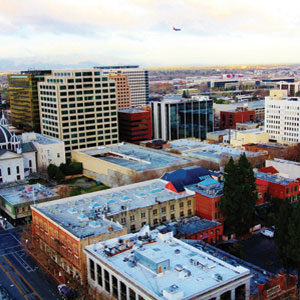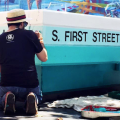Sandwiched between The 88 residential tower where Safeway’s “The Market” sells packages of triple-washed salad greens and San Jose Repertory Theatre’s blue box, a parcel of prime real estate known simply as “Block 3” awaits its destiny.
Within walking distance of pretty much everything the city’s core has to offer, it will be the site of San Jose’s next grand highrise, as originally planned. Or it will just rise to a fraction of its potential.
After shelving highrise plans four years ago when the economy tanked, just how interested is the current owner, The Sobrato Organization, in building high, now that the real estate market is showing signs of revival?
“It’s too early to tell,” says Tim Steele, Sobrato’s senior director of Real Estate. “Depending on the market, depending on the incentives that the city is willing to consider, and how they play and make any of those uses feasible, we have to wait and see.”
In addition to Block 3, Sobrato owns two other prime downtown properties: Block 2, just west of The 88 on San Fernando Street between First Street and Second streets, and Block 8, at the corner of East San Carlos and Market streets.
Downtown’s council representative, Sam Liccardo, says the city is negotiating with developers to encourage them to go higher. “The general position of the developers is that they want to build to seven or eight stories, but not much higher. They don’t want to go to steel,” Liccardo says. Steel framed highrises are generally more expensive to engineer and build than low-rise or mid-rise structures that don’t require thick steel structures for support.
Liccardo, like other proponents of urbanism, fears that without residential density, “retail will continue to struggle.”
With two years remaining on his term, Mayor Chuck Reed wants to see shovels in the ground for dense, high-rise residential buildings. But a lot is pushing those plans back down to earth. Airplanes flying overhead keep buildings shorter than in other cities. Lenders and investors are more risk-adverse than in the past. Gov. Jerry Brown’s war against redevelopment has removed a source of public funding. For these reasons, a new, tall downtown high-rise might be years away, dimming Reed’s opportunity to create a legacy as a downtown builder before he’s out of office.
For years, San Jose has been limited to 17-22 story buildings by FAA flight path requirements, which is why most of the buildings are flat topped and built out to maximum footprint, without the spires or articulation you find in other cities’ architecture.
FAA spokesman Ian Gregor says that the FAA can review and make recommendations on any structure over 200 feet tall and some structures under 200 feet tall if they are close to airports.
Buildings can get taller the further they are from the flight path, but anything built north or south of the San Jose airport —including a thick slice of downtown land—can only be so high.
The city’s hopes for more high-rises was also hobbled last year, when the state Supreme Court ruled in favor of Brown’s property tax grab from 400 redevelopment agencies, including San Jose’s, making it tougher for the city to influence what gets built where.
A handful of developers have approached the mayor and Liccardo or have walked into the Planning Department with construction ideas. City staff members have held internal meetings with the mayor and the Office of Economic Development to try to standardize the development process, with discussions taking place on a parcel-by-parcel basis. The big questions are: Which parcels should be preserved for high-rise? And how does the city prod developers to build higher?
Liccardo identified Santa Clara Street, South First Street and South Market Street as key corridors where the city would expect buildings to fill out the city’s skyline.
“We want high-rise to create this sufficient density to generate foot traffic that will sustain what we all envision to be a bustling downtown with retail and all the amenities that people expect in a big city downtown,” Liccardo says. “But in order to get that foot traffic, you need to have a lot of people, and to have a lot of people you’ve got to build tall.”
The city has extended a hand to property owners and developers. On Jan. 27, the mayor hosted a brainstorming meeting with about 15 downtown office and retail property owners.
At the very least, the meeting was a sign of a recovering economy—developers and property owners dusting off old plans.
“It seems to me we’re starting to see the light at the end of this tunnel,” says Liccardo, “and we need to strike quickly in an uncertain economy. And we need to do everything we can to take advantage of what we see now as an increasingly promising market for development.”
As the clock ticks down on Reed’s mayorship—and with pension reform, a hopeful downtown BART extension and the potential Oakland A’s stadium still not done deals—questions about his lasting legacy spring up.
“The problem that the mayor has is that he’s had very little chance, given the time he’s been in office with the budget woes, to create anything lasting in terms of legacy,” says political consultant Rich Robinson. “And everything he has tried to create has been delayed or denied.”
Robinson said Reed, who declined to comment for this story, has been a “steward mayor” in a time of fiscal downturn, and that “sometimes just being a good steward is not a bad legacy.”
One high-rise project in development is The Carlyle, a 21-story, 327-unit apartment tower that is adjacent to the Axis building and the Hotel De Anza.
“We’ve had our site development permit since the end of 2007,” says Aaron Barger, the Carlyle’s project manager at Barry Swenson Builder.
“We’re working with an investor group now and moving towards submitting a building permit. So we’re a few months out from doing that.”
Barger says the company should break ground sometime this year. The firm has built a few apartment projects over the last few years, including City Heights on West St. James Street near Highway 87, but construction costs and a tepid housing market keeps investors wary.
“It is difficult to get financing for these projects. You’re starting off with the parking garage requirement, [which] is the first component that has to get built, and that’s very expensive,” says Barger. “The construction costs to build these concrete towers is much higher than a wood frame, four-story project. So it’s a long search to find the right financing group to move forward with these.”
To prod developers skyward, Reed and Liccardo directed city staff to develop incentives for developers, who are expected bring something before the City Council this month.
Barger says that incentives can lower the cost on a project by just over a percent, which on a $60 million project is no small chunk of change. But those incentives might not be enough.
“The city’s got a limited amount of influence, if you will, on the economics,” says Sobrato’s Steele. “It’s hard right now to say right now what’s good and viable in downtown.”

 408K Race to the Row
408K Race to the Row  San Jose Jazz Shakeup
San Jose Jazz Shakeup 


